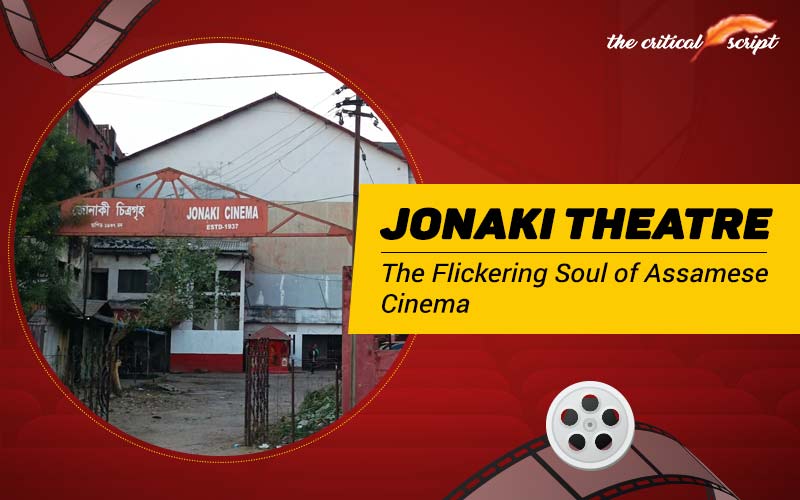
Jonaki Theatre: The Flickering Soul of Assamese Cinema
In the quiet town of Tezpur, where the
Brahmaputra drifts past ancient legends and colonial ruins, stands a crumbling
yet sacred structure - Jonaki Cinema Hall, Assam’s first permanent movie
theatre. Today, its faded façade and creaking wooden beams may not command the
same reverence they once did, but Jonaki is more than brick and mortar. It is a
monument to vision, art, and cultural awakening, the birthplace of cinematic
consciousness in Assam.
The Birth of a Dream (1937)
The year was 1937. India was still under
British rule, and Assam far removed from the cinematic centers of Calcutta or
Bombay had barely tasted the magic of moving pictures. At that time, most film
screenings in the state were organized in makeshift venues: school halls,
temporary tents, or open fields.
Enter Jyoti Prasad Agarwala, the
legendary playwright, poet, composer, and filmmaker — revered today as Rupkonwar (the “Prince of Beauty”) of
Assamese culture. Having already directed Joymoti
(1935), Assam’s first motion picture, he realized that cinema in the region
could not flourish without a dedicated space for exhibition.
Determined to give Assamese films a home
of their own, he built Jonaki Cinema Hall behind his family residence in Pokee,
Tezpur. The name Jonaki, meaning firefly in Assamese, symbolized his
dream, a spark that would light up the cultural darkness of the time.
On an evening in 1937, Jonaki opened its
doors for the first time, screening the British film Elephant Boy to a mesmerized audience. Tezpur had never witnessed
anything like it. The flicker of images on the screen marked the beginning of a
new era.
The Dawn of Assamese Cinema
More than a cinema, Jonaki became a
cultural epicentre, a place where the people of Tezpur gathered to watch films
and exchange ideas, perform plays, and celebrate art.
Through the decades, the hall screened
not only Assamese films like Joymoti
and Indramalati but also Indian and
foreign classics. It became the cradle where the people of Assam learned to
love cinema to see themselves on screen and to understand storytelling as a
mirror to their lives.
Jonaki’s significance lies in this
cultural awakening. It represented a transition from folk theatre to film, from
oral storytelling to visual narrative. It was where rural Assam encountered
modernity not through force, but through art.
A Cultural Landmark in
Decline
For decades, Jonaki stood tall as a
symbol of Assamese pride. Its modest yet dignified structure measured around 27
feet wide and 80 feet long, with a lime-plastered façade, wooden balcony, and
hand-painted posters adorning its walls.
But as the 20th century rolled on, the
glow began to fade. Multiplexes and digital entertainment slowly replaced
single-screen theatres. Maintenance became a challenge, and audience numbers
dwindled.
By the early 2000s, Jonaki had entered a
period of decline. Cracks began to appear in the walls, rain seeped through the
roof, and the once-lively space grew silent.
The state government sanctioned ₹50 lakh
for renovation in 2019, and a foundation stone was laid for its revival but
progress has been painfully slow. As of 2025, the structure stands fragile, its
heritage plaque barely legible, its doors often closed except for occasional
community screenings.
Jonaki’s Enduring Legacy
To call Jonaki just a cinema hall would
be an injustice. It was and remains a living archive of Assamese aspirations.
It symbolizes the courage of a people who, even in the margins of empire,
dreamed of creating their own artistic voice.
Jyoti Prasad Agarwala’s vision for Jonaki
was rooted in self-expression and self-reliance, values that continue to
resonate today. The hall’s legacy reminds us that culture cannot thrive without
infrastructure; that art, to survive, needs not only creators but spaces that
nurture it.
Reviving the Firefly
Today, as heritage activists and
cinephiles call for Jonaki’s restoration, the question arises: how can we
preserve its past while adapting to the future?
A revival plan could see Jonaki
transformed into a heritage-cinema-cum-cultural centre retaining its historical
architecture while integrating digital projection, archival exhibits, and a
museum dedicated to Assamese cinema. The site could host film festivals,
student workshops, and heritage tourism programs, making it once again a beacon
of creativity inTezpur.
Because the spirit of Jonaki that small light Jyoti Prasad
ignited nearly a century ago still flickers beneath the dust and decay. All it needs
is care, and perhaps, a collective act of imagination.
Where the Light Still Glows
Tezpur’s evenings are quiet now, the
laughter and applause that once filled Jonaki replaced by the hum of passing
vehicles. Yet, if you stand near the old gate and listen closely, you might
still hear the echoes of film reels turning, of Jyoti Prasad’s songs drifting
through the air, of the collective heartbeat of a people discovering themselves
through cinema.
Jonaki, in all its ruin and resilience,
is not just a remnant of the past. It is the soul of Assamese cinema, a firefly
that refuses to fade.
Disclaimer: The opinions expressed in this article are those of the author's. They do not purport to reflect the opinions or views of The Critical Script or its editor.

Newsletter!!!
Subscribe to our weekly Newsletter and stay tuned.

















Related Comments